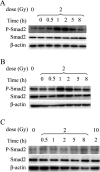Radiosensitization of Non-Small Cell Lung Cancer Cells by Inhibition of TGF-β1 Signaling With SB431542 Is Dependent on p53 Status
- PMID: 27178816
- PMCID: PMC7838670
- DOI: 10.3727/096504016X14570992647087
Radiosensitization of Non-Small Cell Lung Cancer Cells by Inhibition of TGF-β1 Signaling With SB431542 Is Dependent on p53 Status
Abstract
Although medically inoperable patients with stage I non-small cell lung cancer cells (NSCLC) are often treated with stereotactic body radiation therapy, its efficacy can be compromised due to poor radiosensitivity of cancer cells. Inhibition of transforming growth factor-β1 (TGF-β1) using LY364947 and LY2109761 has been demonstrated to radiosensitize cancer cells such as breast cancer, glioblastoma, and lung cancer. Our previous results have demonstrated that another potent and selective inhibitor of TGF-β1 receptor kinases, SB431542, could radiosensitize H460 cells both in vitro and in vivo. In the present study, we investigated whether SB431542 could radiosensitize other NSCLC cell lines, trying to explore the potential implication of this TGF-β1 inhibitor in radiotherapy for NSCLC patients. The results showed that A549 cells were significantly radiosensitized by SB431542, whereas no radiosensitizing effect was observed in H1299 cells. Interestingly, both H460 and A549 cells have wild-type p53, while H1299 cells have deficient p53. To study whether the radiosensitizing effect of SB431542 was associated with p53 status of cancer cells, the p53 of H460 cells was silenced using shRNA transfection. Then it was found that the radiosensitizing effect of SB431542 on H460 cells was not observed in H460 cells with silenced p53. Moreover, X-irradiation caused rapid Smad2 activation in H460 and A549 cells but not in H1299 and H460 cells with silenced p53. The Smad2 activation postirradiation could be abolished by SB431542. This may explain the lack of radiosensitizing effect of SB431542 in H1299 and H460 cells with silenced p53. Thus, we concluded that the radiosensitizing effect of inhibition of TGF-β1 signaling in NSCLC cells by SB431542 was p53 dependent, suggesting that using TGF-β1 inhibitor in radiotherapy may be more complicated than previously thought and may need further investigation.
Figures




References
-
- Reck M.; Heigener D. F.; Mok T.; Soria J. C.; Rabe K. F. Management of non-small-cell lung cancer: Recent developments. Lancet 382:709–719; 2013. - PubMed
-
- Choi N.; Baumann M.; Flentjie M.; Kellokumpu-Lehtinen P.; Senan S.; Zamboglou N.; Kosmidis P. Predictive factors in radiotherapy for non-small cell lung cancer: Present status. Lung Cancer 31:43–56; 2001. - PubMed
-
- Armstrong J.; McGibney C. The impact of three-dimensional radiation on the treatment of non-small cell lung cancer. Radiother. Oncol. 56:157–167; 2000. - PubMed
-
- Kong F. M.; Hayman J. A.; Griffith K. A.; Kalemkerian G. P.; Arenberg D.; Lyons S.; Turrisi A.; Lichter A.; Fraass B.; Eisbruch A.; Lawrence T. S.; Ten Haken R. K. Final toxicity results of a radiation-dose escalation study in patients with non-small-cell lung cancer (NSCLC): Predictors for radiation pneumonitis and fibrosis. Int. J. Radiat. Oncol. Biol. Phys. 65:1075–1086; 2006. - PubMed
-
- Yorke E. D.; Jackson A.; Rosenzweig K. E.; Braban L.; Leibel S. A.; Ling C. C. Correlation of dosimetric factors and radiation pneumonitis for non-small-cell lung cancer patients in a recently completed dose escalation study. Int. J. Radiat. Oncol. Biol. Phys. 63:672–682; 2005. - PubMed
MeSH terms
Substances
LinkOut - more resources
Full Text Sources
Other Literature Sources
Medical
Research Materials
Miscellaneous
